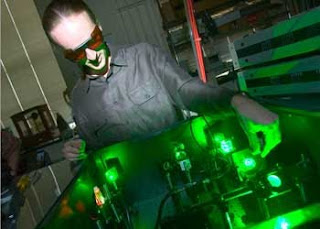I thought I might try describing my job as an academic in a physics department, and comparing that to my current work as an industrial scientist.
Some scene setting: in the UK undergraduates are students who study taught degree courses lasting 3-4 years, typically they start at age 18 or 19. Postgraduates are studying for PhD’s, research courses lasting 3-4 years (after which research councils start getting nasty). After PhD. level there are postdoctoral workers who typically do contract research lasting 2-3 years per contract – they may do multiple contracts at an institution but it’s a rather unstable existence. Permanent academic staff are lecturers, senior lecturers, readers and professors in increasing order of seniority/pay.
As a lecturer-level academic, the shape of the year revolves around teaching, if not the effort involved. Undergraduate students start their year in September, with breaks over Christmas and Easter followed by exams in May/June. The teaching year amounts to about 30 weeks. Should you be lecturing the students, you will spend time preparing and giving lectures; how long this takes depends on your conscientiousness, the number of times you have lectured the course and the number of other things you have to do. In addition you will probably give tutorials, small groups of students working through questions set by other lecturers, practical classes and manage final year undergraduate projects and literature surveys. Compared to a school teacher or further education college lecturer your “contact” time with students will be relatively low – maybe 10 hours a week.
Final year projects are of particular interest to you as a researcher since there’s always vigorous competition amongst academics to attract the best undergraduates to do PhD.’s as postgraduates. A final year project done by a good student can be an excellent way to try an idea out. To be fair to students though, their performance in a final project and talking about that final year project can be the strongest part of a CV – since it demonstrates the ability to work individually in an unknown area.
In between undergraduate teaching there’s grant application writing, doing research of your own, writing papers, and then, come the end of term, the possibility of conferences.
In the end it was the apparently endless futility of writing grant applications which did for me as an academic. My success rate was zero, furthermore I had this terrible feeling that even after successfully winning a grant I would struggle to recruit postdocs or PhD students to do the work and there was little chance that having started a fruitful line of research there would be a good chance of continuing it with further successful grants.
I was recruited to my current company by a recruitment agency, who found my webpage still hanging around at Cambridge University a couple of years after I had left. I didn’t actually end up doing the job they nominally recruited me for but what I do is relevant to my research background and can be rather interesting.
I turned up to my new workplace on the Friday before I started and was shown my desk – in a shared office. I did wonder at that point whether I had done the right thing, back in academia I had an office roughly the size of a squash court and could go days without seeing anyone. As it turns out sharing an office isn’t too bad, you get to find out what’s going on, but it can be a pain when your neighbour decides to have a long, detailed meeting next to you.
Another novel aspect to working in industry is that someone seems interested in my career within the company. In getting on for 15 years as an academic I can remember rarely ever talking about my career with anyone who might have influence on its direction whilst in a company it’s at least an annual occasion. It’s true that the company’s enthusiasm for management-speak can be excessive (and changeable) as new human resources fads come and go.
I get to go to lots of meetings.
Relevant to current discussions on the public sector we have regular restructuring, and in the past year or so: pay freezes, arbitrary cuts in travel budget mid-year, a change to pensions for new recruits, and redundancies – the latest round equivalent to losing about 15% of the people on the site I work at. It’s fair to say that we are not necessarily models of efficiency internally: I heard on the news that it takes 5 signatures for someone in the NHS to buy a new bed costing about £1000 – sounds about par for the course.
One noticeable difference is that largely I feel much more wanted, inasmuch that if I’m put on a project then the project leader will be keen to get some sort of intellectual exertion on my part and will even appear quite pleased when this is achieved. Even better, people for whom I do “a bit on the side” are even more grateful. This is a big difference from being an academic, where the odd student (undergraduate or postgraduate) may appreciate your efforts but largely nobody shows much sign of caring about your research.
Looking back on my time as an academic: I think I would have benefited from some sort of master plan and career direction. I’d quite liked to have carried on as a postdoc, i.e. actually doing research work rather than trying to manage other people doing research. However, this isn’t a career option and is a rather unstable existence.





